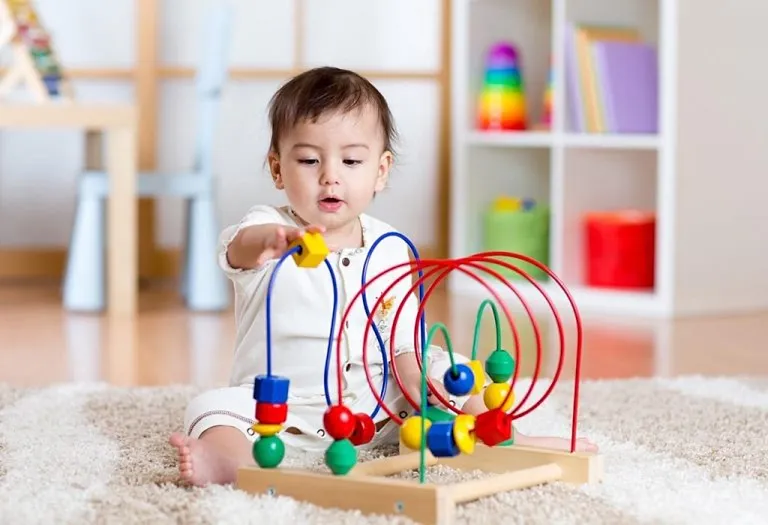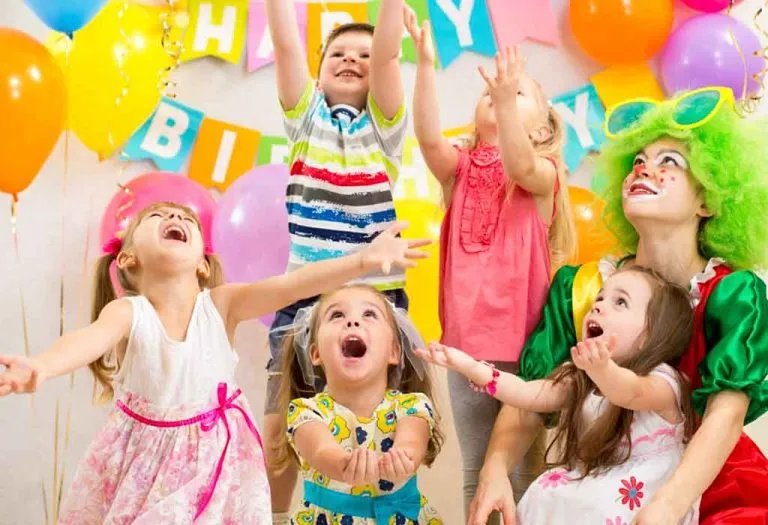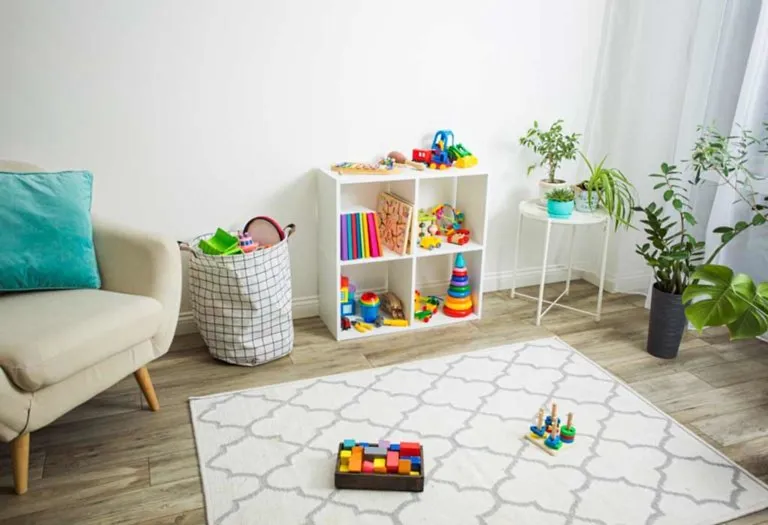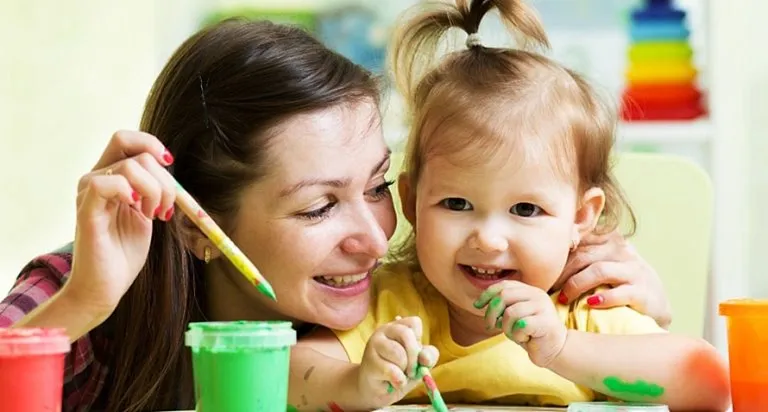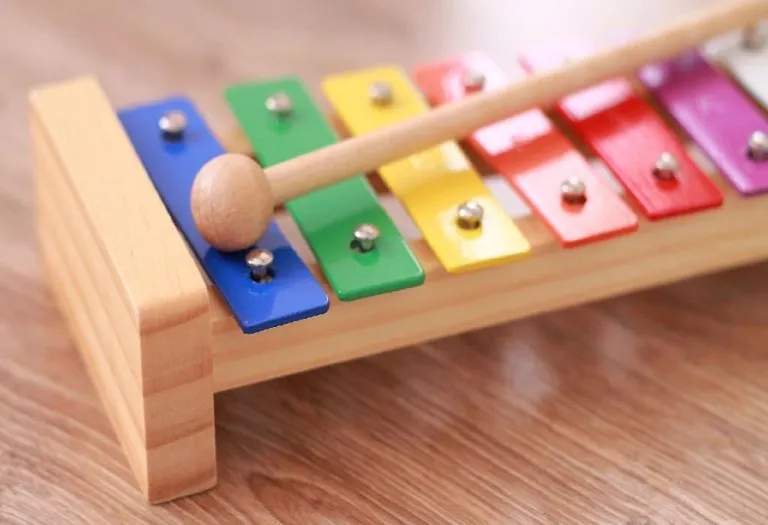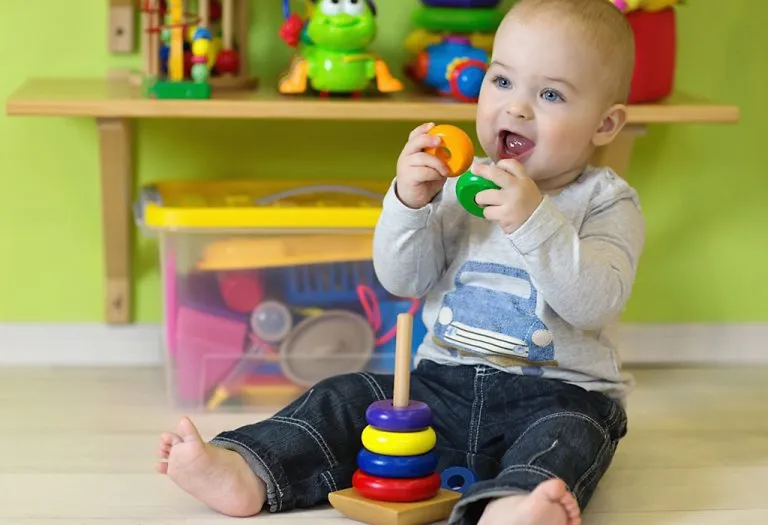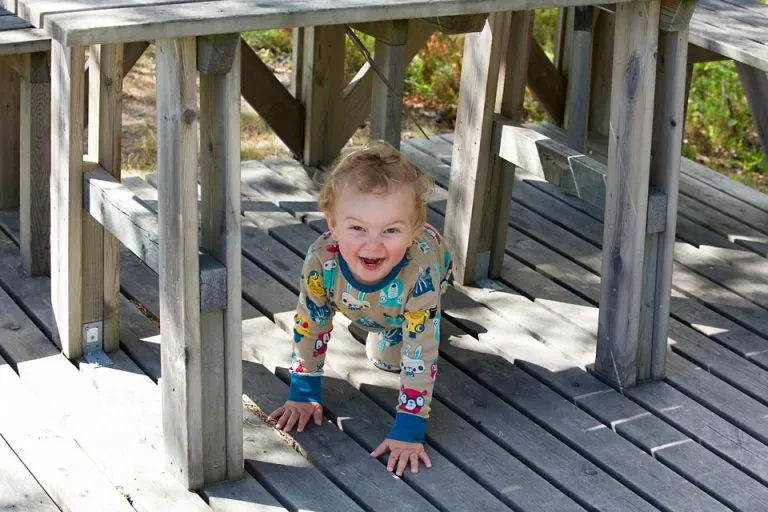Best Toys for 7 Month Old
- Must-have Toys for Seven Month Old Babies
- Why Is Playing Important At a 7-Month Age?
- What Do Age Recommendation Labels on the Toys Mean?
- Safety Tips for Babies
- How to Help Your Baby Learn While Playing?
- How to Choose the Best Toys for Your 7-month-old Baby?
- FAQs
Your baby is becoming independent, from crawling around to recognising and picking up his favourite toy (1). He is learning the concept of controlling the environment whilst having fun with it.
As your baby starts to creep and crawl, encourage these movements by placing toys a little further away from his reach. This way, you can tap into his curious mind, challenge him, and keep him active by being playful. While developing his own unique personality, here are some baby toys for 7-month-old babies to help with his cognitive growth. The following development and learning toys for 7-month-old babies ensure a bright and sharp future for your baby. So, don’t miss out on these toys for seven-month-old cuties and get one from these cool toys for your little sunshine.
Must-have Toys for Seven Month Old Babies
Shape Sorter Toys
The shape sorter toys are designed to help develop your baby’s fine motor skills. Not only is your baby familiarising himself with different shapes, but he is also memorising them by correctly fitting each three-dimensional shape into its corresponding hole.
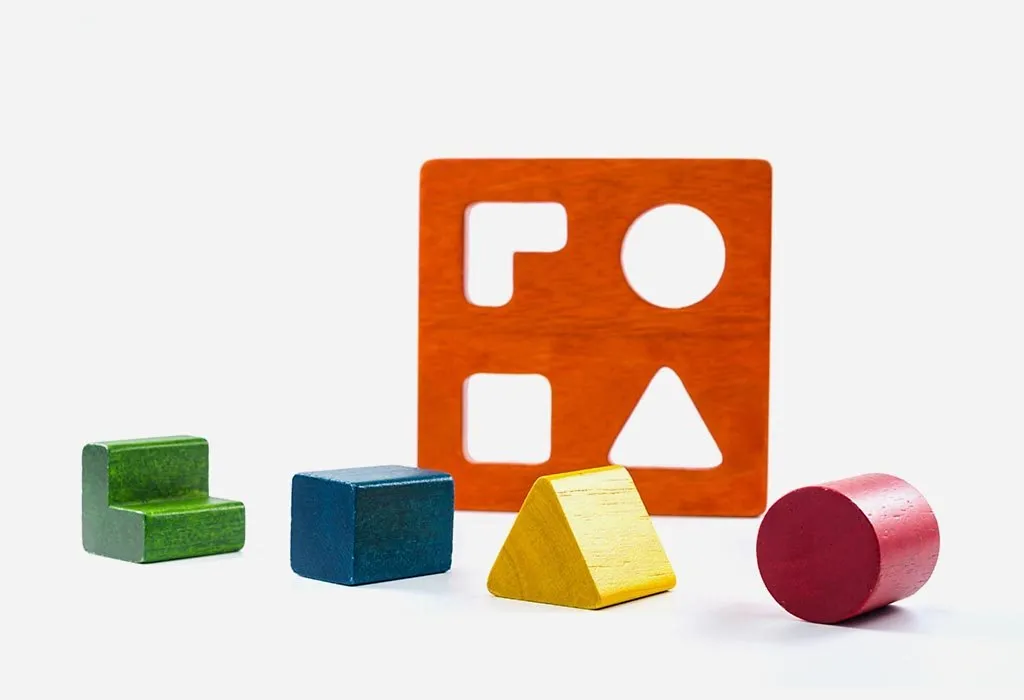
1. Skill Development
- It boosts his self-esteem upon getting the right block into the right hole.
- If your baby tries to insert a square block into a triangle-shaped hole, he may start to brainstorm a solution, thereby using problem-solving skills.
- Your baby is exposed to blocks with a different number of sides, thus making them different shapes. This helps your little one develop hand-eye coordination.
2. Recommended Toys
- Building blocks
- Shape toys with colours to match
- Soft fabric blocks
Action/Reaction Toys
Babies at seven months reach a new level of discovery, wonderment and creativity. They are drawn to different sounds and respond accordingly. Your baby will be fascinated with toys that make sounds, produce lights or move when pressing different coloured buttons.

1. Skill Development
- These toys help in the cognitive development of your baby.
- It also refines motor development if the toy moves slowly, thereby helping your baby to crawl.
2. Recommended Toys
- Building blocks
- Toys that produce lights and sounds by pushing buttons
- Squeaky toys
Soft Stuffed Toys
These toys, in particular, can be your baby’s favourites since they can be cuddled with. Babies can explore such toys in a very safe way. These toys don’t cause any damage when chewed, squeezed or thrown around.
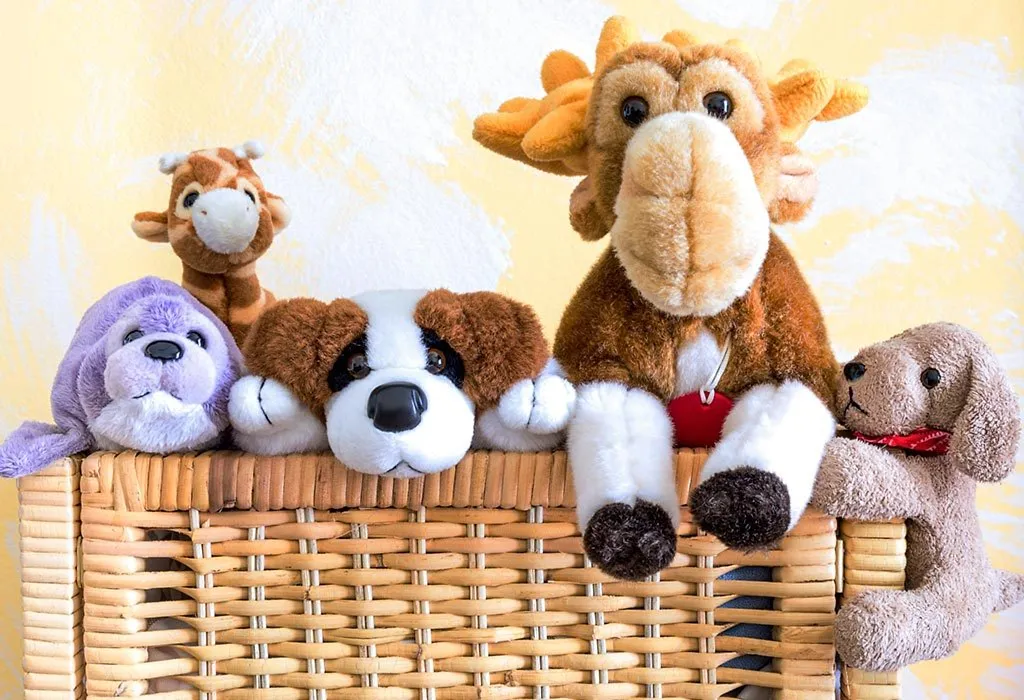
1. Skill Development
- These toys will help your baby get a better sense of grasping the toy.
- With many soft toys to choose from, your baby can recognize different soft toys based on its texture, shape and weight.
- Your baby might want to play with a particular soft toy, carry it around or may even want to sleep with it. This is a sign of attachment in the baby, thereby showing his increasing socioemotional development.
- Soft toys can be your baby’s best friend and comfort in times when he feels tired or is placed in a situation where he has to cope with change. Your baby feels a sense of love with regard to his soft toys.
2. Recommended Toys
- Stuffed Animals
- Soft puppets
- Soft Books
- Colourful Dolls
Noise and Flashy Toys
Your little one will be attracted to this toy as it moves, emits light and makes sounds. It’s a fun way to introduce music and dance to your baby.

1. Skill Development
- Enhances motor skills as your baby will respond to the music by jumping.
- These toys have a lot of buttons which will teach your little one about different sounds upon pressing respective buttons.
2. Recommended Toys
- Toys that have many buttons, which, upon pushing, emit colourful lights and sounds.
- Toys that rattle or have bells.
- Squeaky toys.
Building Blocks
These toys help your baby stay active and creative.
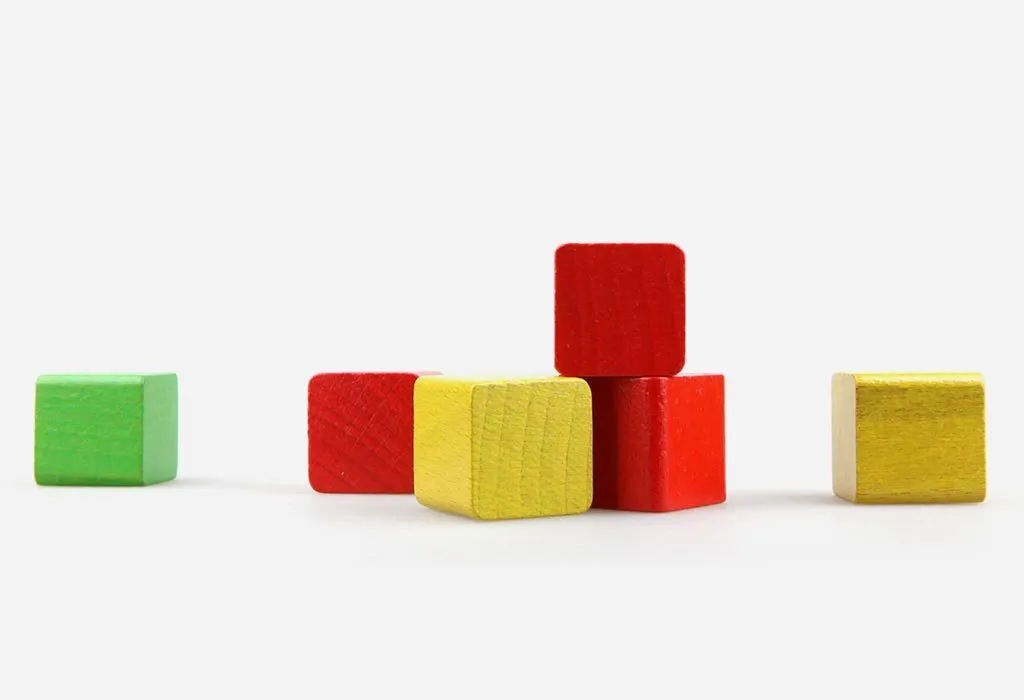
1. Skill Development
- Enhances creativity and cognitive skills while building different structures.
- Develops motor skills like picking, placing, etc.
2. Recommended Toys
- Blocks with projections for assembling and building structures
- Wooden blocks with numbers and alphabets on them
- Squeaky blocks
Push Toys
These toys will not only keep your baby entertained but also help in his physical development.
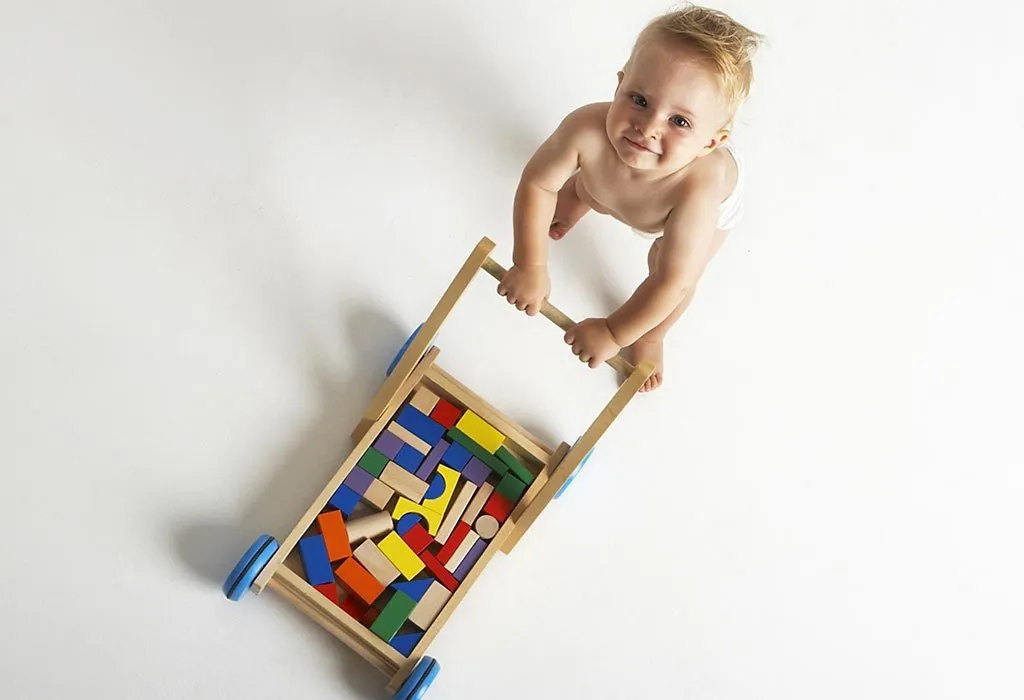
1. Skill Development
- Enhances motor skills
- Enhances hand-eye coordination
- Helps your baby to walk
2. Recommended Toys
- Baby walkers
- Toys with wheels like cars, wagons, etc.
- Toys that can roll easily, like balls
Moving and Rolling Toys
Apart from exercising your baby’s brain, exercising his body is equally important as well.

1. Skill Development
- Enhances motor skills
- Hand-eye coordination
- Enhances flexibility and speed
2. Recommended Toys
- Baby Walkers
- Balls with bells
- Walker wagons
Role Playing Toys
These kinds of toys help your baby understand different actions or roles while imitating them.
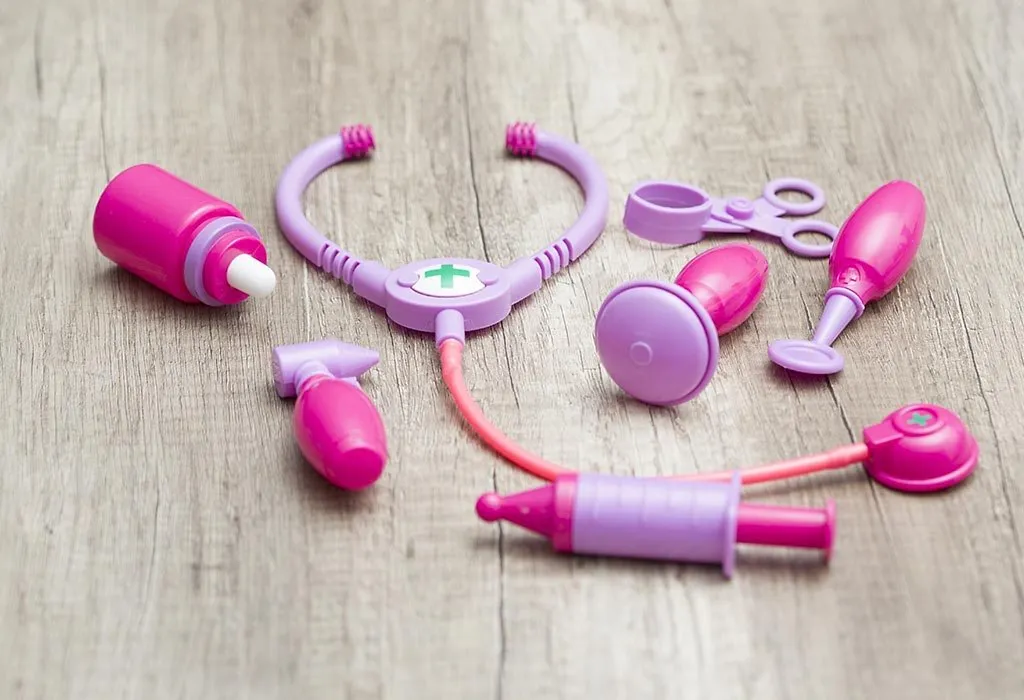
1. Skill Development
- A better understanding of the environment and how grown-ups operate.
- Enhances communication
2. Recommended Toys
- A cricket bat and ball
- Having a pretend conversation on a toy phone
- Toy doctor set
Bath Toys
Sometimes babies don’t really enjoy bath time. However, this can become a fun activity by putting in a few rubber toys in the tub.
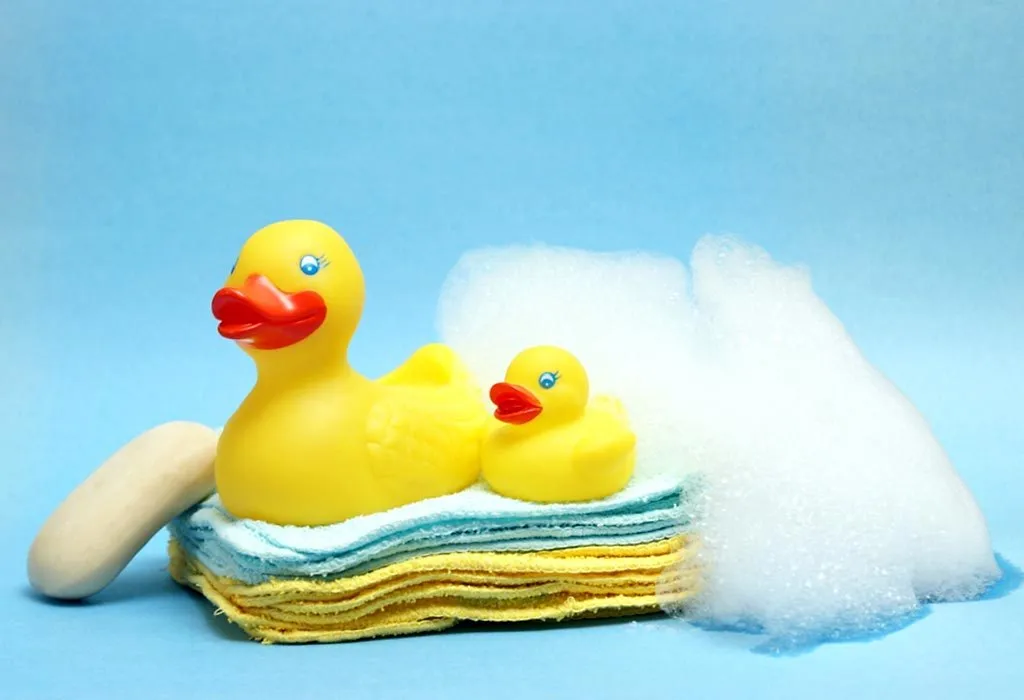
1. Skill Development
- Your baby can learn how toys float on water.
- Exposure to heavy toys sinking in water.
2. Recommended Toys
- Rubber Ducks
- Toy ships or boats
- Sea creature figurines like dolphins, whales, etc. (Age appropriate ones only)
Books and Puzzles
Books and puzzles are learning tools that can enhance your baby’s cognitive development.

1. Skill Development
- Problem-solving
- Hand-eye coordination
- Memory development
- Fine motor development
2. Recommended Toys
- Puzzles with very large pieces
- Building blocks
- Books which have little buttons that produce different sounds, depending on the topic
Household Items
Babies often enjoy and prefer playing with day-to-day items lying around the house. Anything they find is treated as a toy.

1. Skill Development
- Improves motor skills – like crawling towards an item.
- Your baby will learn the names of different items as he plays with them.
2. Recommended Toys
- Baby wipes container – Place a scarf into the container, allowing the baby to pull it out.
- Basket – Direct your baby into putting toys into the basket. This will help his hand-eye coordination.
- Place bowls of different sizes with toys in them to help your baby learn to grasp, transfer toys into another bowl, etc.
Balls
This is a simple yet dynamic toy, with multiple actions that range from rolling to bouncing and being something that’s easy to throw and kick. These benefits can help your baby develop essential skills from a very young age.

1. Skill Development
- It enhances his motor skills while crawling for the ball.
- Your baby can develop hand-eye coordination through the ball bouncing, rolling, etc.
2. Recommended Toys
- Softballs that rattle/light up
- Light, big rubber balls
- Hollow plastic balls
Toys to Handle and Manipulate
Such toys bring about a spark in your baby’s creative mind and build up his communication and imagination through play. These are bright, colourful and have different textures.

1. Skill Development
- Enhances cognitive skills since your little one will learn about different shapes and colours.
- Ability to have control over toys, like brushing a toy doll’s hair.
2. Recommended Toys
Why Is Playing Important At a 7-Month Age?
Play is a crucial part of development for babies, be it at 4 months, 7 months, 2 years, or 14 years. Babies at 7 months of age start learning new things about themselves and their surroundings as they steadily and skillfully master the art of observing things in and around them, like their hands, fingers, feet, things around them, familiar faces around them, etc. Play acts as an accelerator to boost brain development, gross and fine motor skills, and interaction capabilities through colourful and interactive toys.
Toys are a gateway to learning and entertainment for babies and bonding for parents. While some toys teach shapes, numbers, colours, and touch-and-feel, some toys help with listening abilities and improve physical dexterity and cognitive skills (3). Therefore, it becomes imperative for caregivers to choose the most age-appropriate and suitable toys for babies that not only entertain them but also teach them by building their curiosity.
What Do Age Recommendation Labels on the Toys Mean?
Purchasing toys for children can be particularly challenging for parents. There are so many to choose from, but are those toys suitable, safe and appropriate for your little one? Age labelling of toys is a guided method to help you make a wise choice based on your baby’s developmental needs. These are some pointers reflecting on the importance of age labels on toys:
- Reflecting on how safe the toy is for your baby
- These toys go through testing, ensuring that they have not been made using any toxic material
- Ensuring that the toys are unbreakable to a high degree
- No choking hazards
- Excellent knowledge of child development
- Finding out the popularity of the type of toy for a certain age group
- Based on age groups, some prove to be educational toys for 7-month-old babies.
Safety Tips for Babies
- Make sure you choose an age-appropriate toy for your little one based on his development and interest.
- It’s always better to buy toys that are easy to clean and larger than their mouth since babies have the habit of putting anything they find into their mouths (4).
- Any plastic wrapper around the toy must be discarded as there could be a risk of suffocation.
- The toys must be inspected for sharp edges. Stuffed animals can be made of metal wires.
- Any toy which is broken must be discarded immediately to prevent injuries.
- If your baby is under age 1, choose toys that are light, soft, and colourful and made from non-toxic materials.
- Your older child must be taught to keep his toys away from his younger siblings, especially if those toys are made from smaller parts.
- Do not leave them alone with toys during bath time, as they could drown if left unsupervised.
How to Help Your Baby Learn While Playing?
Your baby will start communicating with you through gestures like nodding, pointing and waving. At this age, babies learn as they crawl. Exploration is key. Apart from crawling, they are capable of sitting straight on their own and trying to get to a standing position by holding onto furniture. To help enhance the learning experience for your baby, here’s what you need to do.
- Read books to your baby which are colourful and with interesting illustrations. Point to the objects in the book that your baby sees on a daily basis in the real world.
- Teach your little one action songs like ‘Itsy Bitsy Spider’ or ‘Twinkle Twinkle Little Star.’
- Allow your baby to grab and explore household items within reach.
- Take your little one for a walk in the park and point to different objects to help him connect words and the image.
- Communicate with your baby by responding to his sounds.
- Offer your little one an assortment of foods that have different textures.
How to Choose the Best Toys for Your 7-month-old Baby?
At seven months, your baby isn’t content to lie in one place. He wants to move around and explore for himself. Early childhood development revolves around exploration and experimentation. There is a lot more to think about while choosing the right kind of toy for your little one, as it influences early development. Here are a few picks for your baby to play with:
- Toys that serve as teethers are perfect since your baby is due for his first tooth.
- Toys that engage your baby in a high chair while you are finishing up chores.
- Floating, squirting, and squeaky bath toys make bath time fun for little ones. It develops his motor skills as they try to grasp these toys.
- Toys that are mentally challenging but not frustrating to your little one.
- Toys must be purchased from a reliable company and should be long-lasting and age-appropriate.
FAQs
1. What does baby development at 7 months look like?
At the age of 7 months, your cutie patootie is becoming increasingly aware of its surroundings. It has started observing objects around it closely and may bang them on the floor or on objects just to see what happens next. This is its budding, curious mind taking charge. It will start expressing its emotions with smiles and verbally with happy shrieks, squeals, and babbling sounds.
2. What milestones do babies achieve at 7 months of age?
You may expect your 7-month-old baby to achieve the following milestones as per Mayo Clinic (5):
- Rolling over from front to back and back again
- Sitting up without support
- Reaching out with one hand
- Passing objects from one hand to the other
- Grasping items using the whole hand
- Seeing in full colour and following moving objects with their eyes
- Responding to their name and basic words like “no”
- Finding objects that are partially hidden
- Exploring items by touching and mouthing them
Remember, each child grows and develops uniquely, so it is not necessary for a child to be behind in his growth if he does not achieve all the milestones per his age. Be patient and make sure he eats, plays, and poops well.
3. What are the best toys for a 7-month-old baby?
Seven months is a perfect time to introduce children to musical toys like a mini guitar or mini keyboard, puppets, interactive balls, toy cars, baby blocks, and activity tables. Classic toys like wooden construction toys, hardwood blocks, and a set of wooden vehicles and road signs were found to be among the best toys for seven-month-old babies as they prompted social interaction, problem-solving skills, and creative expression in babies (6).
It is essential to encourage your baby to learn, stay creative and feed his curiosity. He is at an are at an age where they want to physically explore his surroundings. These fun ways of engaging with your baby contribute to long-term benefits of mental and physical development.
References/Resources:
1. Your baby’s growth and development – 7 months old; Pregnancy Birth & Baby; https://www.pregnancybirthbaby.org.au/babys-growth-and-development-7-months-old
2. Toy Buying Tips for Babies & Young Children: AAP Report Explained; American Academy of Pediatrics; https://www.healthychildren.org/English/ages-stages/baby/Pages/What-to-Look-for-in-a-Toy.aspx
3. Blue Sky Science: How do toys affect a baby’s development?; Morgridge Institue for Research; https://morgridge.org/blue-sky/how-do-toys-affect-a-babys-development/
4. How to Buy Safe Toys; American Academy of Pediatrics; https://www.healthychildren.org/English/safety-prevention/at-home/Pages/How-to-Buy-Safe-Toys.aspx
5. Infant development: Milestones from 7 to 9 months; Mayo Clinic; https://www.mayoclinic.org/healthy-lifestyle/infant-and-toddler-health/in-depth/infant-development/art-20047086
6. What the Research Says: Impact of Specific Toys on Play; NAEYC; https://www.naeyc.org/resources/topics/play/specific-toys-play
Also Read:
Food Ideas for 7 Month Old Babies
Best Learning Activities For 7 Month Old Baby
7 Month Old Feeding Schedule, Recipes and Tips
Your 7 Months Old Baby Growth and Development
Was This Article Helpful?
Parenting is a huge responsibility, for you as a caregiver, but also for us as a parenting content platform. We understand that and take our responsibility of creating credible content seriously. FirstCry Parenting articles are written and published only after extensive research using factually sound references to deliver quality content that is accurate, validated by experts, and completely reliable. To understand how we go about creating content that is credible, read our editorial policy here.






